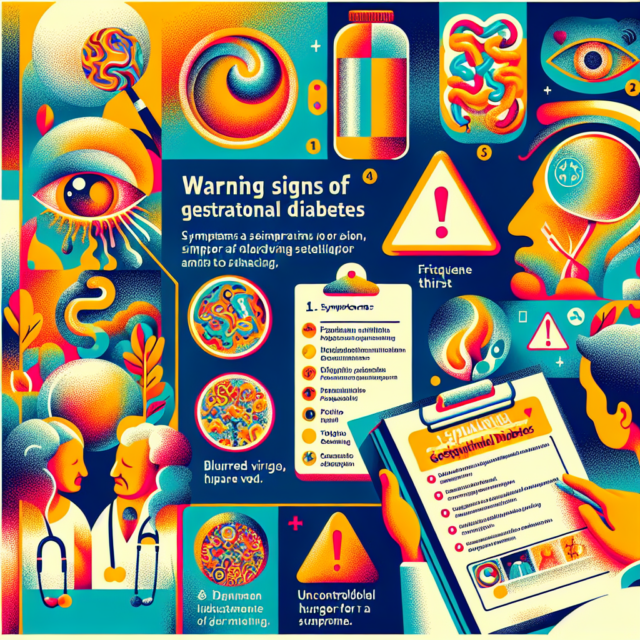
Postpartum gestational diabetes, a condition where blood sugar levels remain elevated after pregnancy, can pose serious health risks if not properly managed. Recognizing the warning signs early can help in seeking timely medical intervention and adopting lifestyle changes to mitigate long-term complications. This article aims to shed light on understanding postpartum gestational diabetes, identifying early indicators, and recognizing both physical and emotional symptoms to watch for after pregnancy.
Understanding Postpartum Gestational Diabetes
Postpartum gestational diabetes occurs when a woman who had gestational diabetes during pregnancy continues to have elevated blood sugar levels after giving birth. Typically, gestational diabetes resolves itself after the baby is born, but in some cases, the blood sugar levels do not return to normal, leading to a condition that requires ongoing management. Understanding this condition is crucial for new mothers to ensure their well-being and that of their newborn.
This condition can increase the risk of developing type 2 diabetes later in life. Women who have had gestational diabetes are particularly susceptible, and the risk remains elevated even after pregnancy. Therefore, recognizing and understanding the signs of postpartum gestational diabetes is essential for timely intervention and prevention of long-term health issues.
Healthcare providers often recommend regular monitoring of blood sugar levels after pregnancy for women who had gestational diabetes. This helps in early detection and management. Being informed about the condition, its risks, and its potential impact can empower women to take proactive steps towards their health.
Early Indicators of Postpartum Blood Sugar Issues
One of the early indicators of postpartum blood sugar issues is persistent hyperglycemia, where blood sugar levels remain higher than normal even after childbirth. Regular monitoring through self-administered blood tests can reveal patterns that suggest the body is not effectively managing glucose levels. If these elevated levels persist, it may indicate the presence of postpartum gestational diabetes.
Another early indicator is the presence of glucose in the urine, detectable through routine postpartum check-ups. This can be a sign that the kidneys are attempting to expel excess glucose from the bloodstream, a clear indication that blood sugar levels are not within the healthy range. Women with a history of gestational diabetes should be particularly vigilant about such signs.
Frequent infections, especially urinary tract infections (UTIs) and yeast infections, can also be early indicators. High blood sugar levels create an environment that promotes the growth of bacteria and yeast, leading to recurrent infections. Noticing an increase in the frequency or severity of such infections can be a critical sign of underlying blood sugar issues.
Physical Symptoms to Watch for After Pregnancy
Physical symptoms that may indicate postpartum gestational diabetes include excessive thirst and frequent urination. These symptoms occur as the body attempts to rid itself of excess glucose through urine, leading to dehydration and a constant need to drink fluids. While these symptoms can be common after pregnancy, their persistence and intensity can be a red flag.
Unexplained weight loss despite maintaining a regular diet can also be a symptom. When the body is unable to use glucose for energy due to insulin resistance, it begins to break down fat and muscle for fuel, leading to weight loss. This can be concerning, especially when combined with other symptoms of high blood sugar.
Fatigue and lethargy are additional physical symptoms to watch for. High blood sugar levels can impair the body’s ability to effectively use glucose for energy, resulting in persistent tiredness. This fatigue can be more pronounced than the usual exhaustion associated with caring for a newborn and may not improve with rest.
Emotional and Behavioral Warning Signs to Notice
Emotional and behavioral changes can also signal postpartum gestational diabetes. Mood swings and irritability may become more frequent as blood sugar levels fluctuate. These emotional changes can be more intense and persistent than typical postpartum mood disturbances and may affect daily functioning and relationships.
Depression and anxiety are other significant emotional signs. The stress of managing a newborn combined with the physical toll of high blood sugar levels can contribute to feelings of hopelessness and anxiety. These emotional states can interfere with a mother’s ability to care for her baby and herself, necessitating prompt attention and support.
Cognitive issues such as difficulty concentrating and memory problems can also be behavioral warning signs. High blood sugar levels can impair cognitive function, making it hard to focus or remember tasks. These cognitive difficulties can be particularly challenging for new mothers who are already adjusting to the demands of parenthood.
Recognizing the warning signs of postpartum gestational diabetes is crucial for managing the condition effectively and preventing long-term health complications. By understanding the early indicators, physical symptoms, and emotional and behavioral changes associated with this condition, new mothers can seek timely medical advice and take proactive steps towards their health. Monitoring and addressing these signs can significantly improve quality of life and ensure a healthier future for both mother and child.
